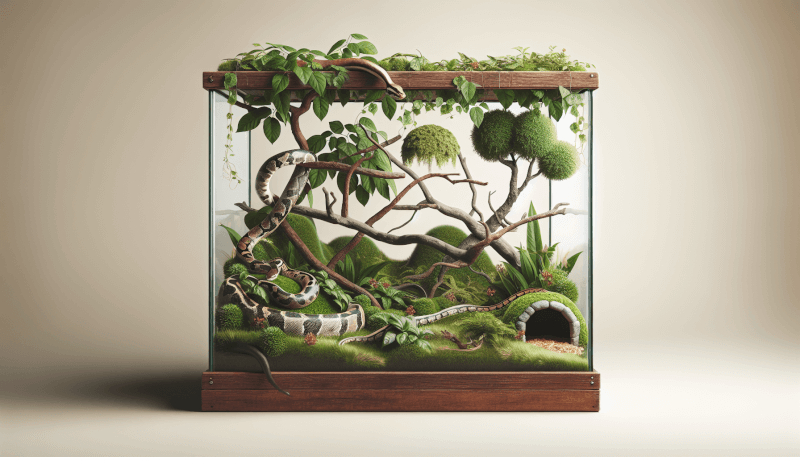Imagine a home for your slithering friend that mimics their natural habitat in the wild, providing them with an environment that encourages physical and mental stimulation. Creating a natural and enriching habitat for your snake not only promotes their overall well-being but also enhances their natural behaviors. From selecting the perfect enclosure to incorporating realistic landscapes and enrichment items, this article will guide you in transforming your snake’s habitat into a peaceful haven that promotes their health and happiness.

Choosing the Right Enclosure
Enclosure size
When choosing an enclosure for your snake, it’s important to consider the size. Snakes come in a variety of sizes, and the enclosure should provide enough space for your snake to comfortably move around and engage in natural behaviors. A general rule of thumb is to provide a cage that is at least the length of your snake plus half of its length for adequate space.
Enclosure type
The type of enclosure you choose for your snake will depend on the species and its specific needs. There are various options available, such as glass tanks, plastic tubs, or customized wooden enclosures. It’s essential to select an enclosure that provides proper ventilation and security.
Substrate
Choosing the right substrate for your snake is crucial for several reasons. The substrate not only provides a comfortable and natural flooring for your snake but also helps maintain proper humidity levels and aids in waste management. Some popular substrate options include aspen shavings, cypress mulch, and reptile carpet.
Hiding places
Snakes are known to be secretive creatures and require hiding places within their enclosure. These hiding spots provide a sense of security for snakes and allow them to exhibit natural behaviors. You can create hiding places using various materials such as rocks, logs, or commercially available reptile caves. These hiding places should be placed at both the warm and cool ends of the enclosure to accommodate the snake’s temperature preferences.
Temperature and Humidity
Heating equipment
Maintaining the correct temperature gradient is vital for your snake’s overall health and well-being. Provide a heat source, such as a heat mat or ceramic heat emitter, to create a warmer area in one part of the enclosure and a cooler area in another. This allows your snake to regulate its body temperature effectively. Additionally, using a thermostat ensures that the temperature remains consistent and prevents overheating.
Temperature gradient
Setting up a proper temperature gradient within the enclosure is essential for your snake’s thermoregulation. The warm end of the enclosure should have a temperature range between 85-90°F (29-32°C) during the day, while the cooler end should be around 75-80°F (24-27°C). This temperature gradient allows snakes to move to different areas within the enclosure to control their body temperature as needed.
Humidity levels
Snakes have specific humidity requirements based on their natural habitat. Research the ideal humidity range for your snake species and strive to replicate it within the enclosure. This can be achieved by misting the enclosure regularly with water or using a humidity box or reptile fogger. Monitoring and adjusting humidity levels using a hygrometer is crucial to prevent issues like dehydration or respiratory problems.
Lighting and Photoperiod
UVB lighting
Providing UVB lighting for your snake is essential, especially for species that are active during the day and require exposure to sunlight in their natural habitat. UVB rays help snakes synthesize vitamin D3, which aids in calcium metabolism and overall health. Utilize UVB bulbs specifically designed for reptiles and ensure they have the appropriate intensity and wavelength.
Day and night cycle
Creating a day and night cycle within the enclosure helps regulate the snake’s natural circadian rhythm. Use a timer to provide a consistent light-dark cycle and mimic the natural lighting patterns of the snake’s native environment. Providing around 12-14 hours of light and 10-12 hours of darkness is generally suitable for most snake species.
Furnishing and Decorations
Branches and perches
Adding branches and perches to your snake’s enclosure provides opportunities for climbing and exercise. Make sure the branches are securely placed to prevent any accidents or injuries. Choose branches of appropriate thickness and texture that can support the weight of your snake.
Artificial plants
Including artificial plants in the enclosure not only enhances the aesthetic appeal but also creates a more natural and enriching environment for your snake. Choose non-toxic plants that are suitable for reptile habitats and arrange them in a way that provides additional hiding spots and visual barriers for your snake.
Water dish
A water dish is essential for your snake’s hydration needs. Choose a shallow dish that is wide enough for your snake to soak in if desired. Ensure the water is kept clean and replenished regularly to prevent the spread of bacteria. Additionally, placing the water dish in a cooler area of the enclosure helps provide a temperature gradient and increases humidity levels.
Climbing structures
Snakes, especially arboreal species, enjoy climbing and exploring their environment. Adding climbing structures such as driftwood or PVC pipes can provide opportunities for exercise and mental stimulation. These structures should be placed securely and offer stable footing for your snake.

Creating a Natural Environment
Background scenery
Creating a natural environment within the enclosure can be achieved by adding background scenery. You can use naturalistic wallpapers or posters featuring scenes from your snake’s native habitat. This not only enhances the visual appeal but also provides a sense of familiarity and comfort for your snake.
Natural substrates
Using natural substrates, such as coconut husk fiber or cypress mulch, helps create a more realistic and enriching environment for your snake. These substrates provide opportunities for burrowing and exploration, mimicking the snake’s natural habitat. Ensure the substrate is safe and does not pose any ingestion risks.
Live plants
Including live plants in the snake enclosure can have several benefits. Live plants not only increase the visual appeal but also help maintain proper humidity levels and improve air quality. Choose non-toxic plants that are appropriate for reptile habitats and ensure they receive proper light and care to thrive in the enclosure.
Feeding and Watering
Feeding schedule
Establishing a regular feeding schedule for your snake is essential for proper nutrition and overall health. Consult reputable sources or a veterinarian specializing in reptiles to determine the appropriate feeding schedule for your snake species. Younger snakes typically require more frequent feedings compared to adults.
Proper feeding techniques
When feeding your snake, it’s important to use proper techniques to ensure their safety and prevent any injuries. Consider using feeding tongs or long-handled utensils to offer prey items, especially for larger snakes. Avoid handling your snake immediately after they have ingested their meal to prevent regurgitation.
Water requirements
In addition to the water dish, some snake species may require additional hydration through misting or soaking. Research your snake’s specific water requirements and provide additional water sources if necessary. Monitoring your snake’s water intake and ensuring it has access to fresh, clean water at all times is crucial for their overall hydration and health.

Cleaning and Maintenance
Regular cleaning routine
Maintaining a clean enclosure is essential for your snake’s health and to prevent the growth of harmful bacteria or parasites. Establish a regular cleaning routine that includes removing any waste, refreshing the substrate, and disinfecting the enclosure periodically. Regular cleaning also helps eliminate odors and keeps the enclosure hygienic.
Substrate maintenance
Proper maintenance of the substrate is critical to ensure its cleanliness and prevent the buildup of waste or harmful bacteria. Depending on the type of substrate used, this may involve spot cleaning soiled areas, completely replacing the substrate periodically, or sifting through loose substrates to remove debris.
Disinfecting the enclosure
Periodically disinfecting the enclosure helps maintain a healthy living environment for your snake. Use reptile-safe disinfectants and follow the instructions provided by the manufacturer. Pay attention to commonly touched surfaces such as the water dish, hides, and climbing structures. After disinfection, thoroughly rinse the enclosure to remove any residue before reintroducing your snake.
Monitoring and Observation
Observing behavior
Regularly observing your snake’s behavior is crucial for detecting any signs of illness or stress. Familiarize yourself with your snake’s normal behavior patterns, such as eating habits, activity levels, and basking preferences. Any sudden changes in behavior may indicate an underlying health issue that requires attention.
Tracking health and condition
Keeping track of your snake’s overall health and condition is beneficial in identifying any potential health concerns early on. Note any changes in weight, shed cycles, or appearance. Regularly monitor and maintain a record of their feeding and shedding habits, as well as any visits to the veterinarian.
Recording observations
Maintaining a journal or record of your snake’s behavior and health observations can provide valuable insights over time. Note any significant events, changes in behavior, shedding patterns, or feeding responses. This record can be useful for future reference or sharing with a reptile veterinarian if needed.

Handling and Enrichment
Safe handling techniques
Proper handling techniques are crucial for both your safety and the well-being of your snake. When handling your snake, ensure that you provide support to their entire body and avoid sudden movements. Always wash your hands before and after handling to prevent the spread of bacteria, and be aware of their mood and body language.
Environmental enrichment
Enriching your snake’s environment helps provide mental stimulation and prevents boredom. Offer a variety of hideaways, climbing structures, and different textures to explore. Introducing novel objects or scents can also stimulate their senses and keep them engaged. Regularly change and rotate the enrichment items to maintain their effectiveness.
Providing mental stimulation
Snakes, like all animals, benefit from mental stimulation. Encourage natural behaviors such as hunting by using food puzzles or hiding prey items for them to find. Introduce new scents or textures, and occasionally rearrange the enclosure to provide novelty and stimulate their senses. Engage in interactive play sessions with your snake using appropriate toys or objects.
Health and Veterinary Care
Regular check-ups
Regular veterinary check-ups are essential to ensure your snake’s overall health and detect any potential issues early on. Seek a veterinarian who specializes in reptiles and schedule routine examinations according to their recommendations. These check-ups can include physical examinations, fecal tests, and other diagnostic procedures to assess your snake’s well-being.
Common snake health issues
Familiarize yourself with common health issues that snakes may encounter. These can include respiratory infections, parasites, shedding difficulties, and nutritional deficiencies. Learn to recognize the signs and symptoms of these conditions and seek veterinary care promptly if you suspect any health concerns.
Finding a reptile veterinarian
Finding a reputable veterinarian experienced in reptile care is crucial for your snake’s health and well-being. Seek recommendations from fellow reptile owners, local reptile clubs, or online reptile communities. A knowledgeable and experienced reptile veterinarian will provide the necessary expertise and guidance for your snake’s specific health needs.
Creating a natural and enriching habitat for your snake is not only aesthetically pleasing but also essential for their overall health and well-being. By carefully considering the enclosure size, temperature, lighting, and other factors, you can provide an environment that mirrors their natural habitat and promotes natural behaviors. Remember to regularly observe your snake, maintain proper hygiene, and seek veterinary care as needed to ensure a long and fulfilling life for your scaly friend.



